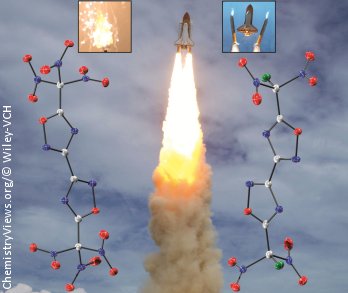The development of energetic materials, with respect to propellants and energetic oxidizers, faces several challenges. Materials with high performance, improved environmental compatibility, and a high oxygen balance are desirable. These oxygen-carrying materials are the main ingredient in solid rocket composite propellants, and ammonium perchlorate is currently one of the most important oxidizers worldwide. Because of the toxicity of the perchlorate anion, and the release of HCl on combustion, alternatives to ammonium perchlorate are required.
Thomas M. Klapötke, Ludwig-Maximilian University of Munich, Germany, and colleagues have developed a convenient route to 3,3′-bis(1,2,4-oxadiazoles) bearing trinitromethyl and fluorodinitromethyl moieties; 5,5′-bis(trinitromethyl)-3,3′-bi(1,2,4-oxadiazole) was synthesized by a route involving the decarboxylative nitration of 3,3′-bi(1,2,4-oxadiazolyl)-5,5′-diacetic acid by using fuming nitric acid in concentrated sulfuric acid. Subsequent fluorination gave 5,5′-bis(fluorodinitromethyl)-3,3′-bi(1,2,4-oxadiazole).
To determine the energetic behavior of these compounds their thermal stability and sensitivity were investigated and standardized impact and friction tests were carried out. These two hydrogen-atom-free molecules displayed remarkably high densities, which can be explained by the interaction between the molecules within the crystal, resulting in high performance. Advantageously, the combustion of the trinitromethyl derivative produces no toxic substances.
- 3,3′-Bi(1,2,4-oxadiazoles) Featuring Fluorodinitromethyl and Trinitromethyl Groups,
Marcos A. Kettner, Konstantin Karaghiosoff, Thomas M. Klapötke, Muhamed Suceska, Swetlana Wunder,
Chem. Eur. J. 2014.
DOI: 10.1002/chem.201402291



